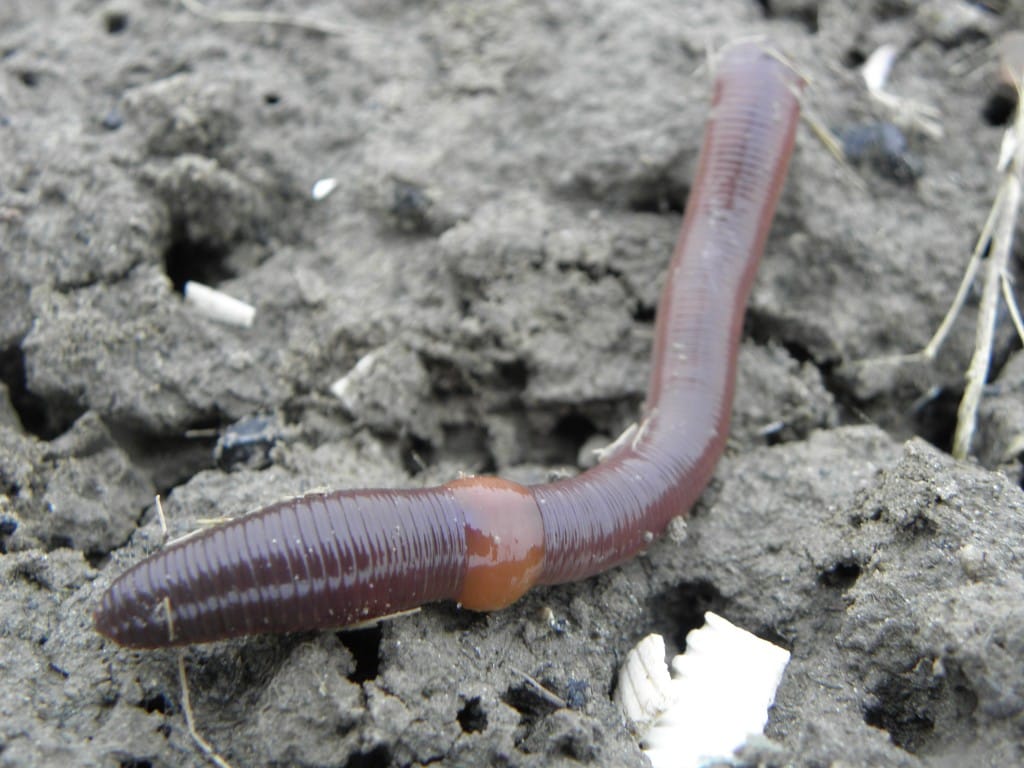Source(s): University of California
Earthworms encompass a large group of soil dwelling worms in the phylum Annelida. The most common species found in turf are in the family Lumbricidae including the nightcrawler, Lumbricus terrestris. These worms are brownish-red and grow up to a few inches long. Their bodies are cylindrical with about 150 segments. In turfgrass, earthworms are primarily seen at night or when they are driven out of the soil by watering. Where high populations of earthworms are present, small mounds, or castings of fecal matter, are deposited on the soil or lawn surface.
Hosts
Earthworms may be found in soils under all turfgrass species.
Damage from Earthworms
Earthworms are not pests of turfgrass and do not feed on turf. Earthworms swallow soil as they burrow and feed on microorganisms and partially decomposed organic matter in the soil. Their role in a lawn is primarily beneficial. Thatch buildup has been associated with reduced earthworm populations. Burrowing helps to mix some of the nutrients in the soil together as well as decompose organic matter in the soil. Earthworm activity improves aeration, increasing water and nutrient movement through the soil. Earthworms deposit castings when they ingest soil and leaf tissue and emerge from the soil surface to remove fecal matter. Castings are rich in nutrients and organic matter and can provide some benefits to turfgrass plants. However, when casting piles become large, they may be considered unsightly and over time may make the lawn lumpy. Occasionally, moles may burrow in lawns with high earthworm populations to feed on them.
Monitoring of Earthworms
Look for small mounds or castings on the soil or turfgrass surface. Earthworms often rise up to the soil surface or sidewalk after a rain or irrigation.
Management of Earthworms
Rake castings to remove them. Power raking with a thatching rake adjusted so the teeth will drag through mounds but not down to the turf crowns will be more effective than hand raking. Adjust your irrigation schedule so the top layer of soil dries out between irrigations. This will drive worms deeper into the soil. Turf mowed at the higher end of the recommended height may hide castings. Earthworms have some natural enemies such as ants, centipedes, birds, snakes, toads, carabid beetles, and nematodes. Do not apply pesticides to control earthworms.
Are you concerned about a bumpy, rough area in your lawn? Does a close inspection of your lawn reveal a miniature replica of the Blue Ridge Mountains ? Such areas can be annoying, difficult to mow and even dangerous for anyone walking or running across them. What causes these bumps? And, more importantly, how do you get rid of them?
There can be several reasons for bumpy lawn conditions. Sometimes the repeated freezing and thawing conditions of winter and early spring move the soil up and down. In other cases, older and more established lawns become rough and uneven over time as the turfgrass gradually thins out. Thinning lawns can be caused by shade, insect damage, and poor maintenance practices. Re-establishing a healthy, thick turf will help improve this situation.
Another possible cause of bumpy and rough lawns is the presence of earthworms. In such cases, it is the movement of earthworms in the soil and the castings that they leave behind on the soil surface that cause the roughness. Castings are the result of the ingestion and excretion of soil and plant litter by the worms. You may also notice that the activity of earthworms is greatest in the spring and fall when soil moisture conditions and temperatures are conducive to their activity.
The problem of earthworm “damage” to turfgrass areas is a complex one. On one hand, a population of earthworms is usually an indicator of healthy turfgrass. On the other hand, the bumps that sometimes occur as a result of earthworm activity are unsightly and can make it difficult to mow your lawn without scalping the bumpy areas. These spots may also be a safety concern if you have trouble walking over them.
In a lawn, earthworms work as natural aerators. They turn over the soil in a steady and methodical manner without any real disruption to the turfgrass. Their holes improve the movement of water and nutrients into the soil and make them more available to the lawn. In addition, earthworms are some of the best decomposer organisms that exist in the soil. They decompose thatch and, by doing so, help recycle nutrients and make them available to the grass again.
Generally speaking, it is desirable to have a healthy population of earthworms in your lawn. If earthworm activities become problematic for you, however, there are a few things you can do. The best techniques to alleviate earthworm “damage” include basic, good lawn care practices. These practices are detailed in UGA Extension Bulletin #773, “Lawns in Georgia.” Good lawn care practices include the following: a basic fertilization schedule, aeration of the lawn and over-seeding to fill in thin patches.
Another basic lawn care practice that can help control the bumpiness caused by earthworms is proper irrigation. Generally, earthworms only become a nuisance when the soil is extremely moist and they must surface for air. This is why they are often seen in the spring as the soil thaws and soil moisture is high. Irrigating less frequently and deeply during the growing season will keep earthworm populations deeper in the soil profile so that they are not creating bumps and castings on the surface. On the other hand, frequent and shallow irrigations can encourage earthworms to stay near the surface. It is also important to keep in mind that earthworm populations are harmed by the use of certain lawn care pesticides and there is not any pesticide products labeled for their control. If you use these products, understand that that harm may be done to earthworm populations.
